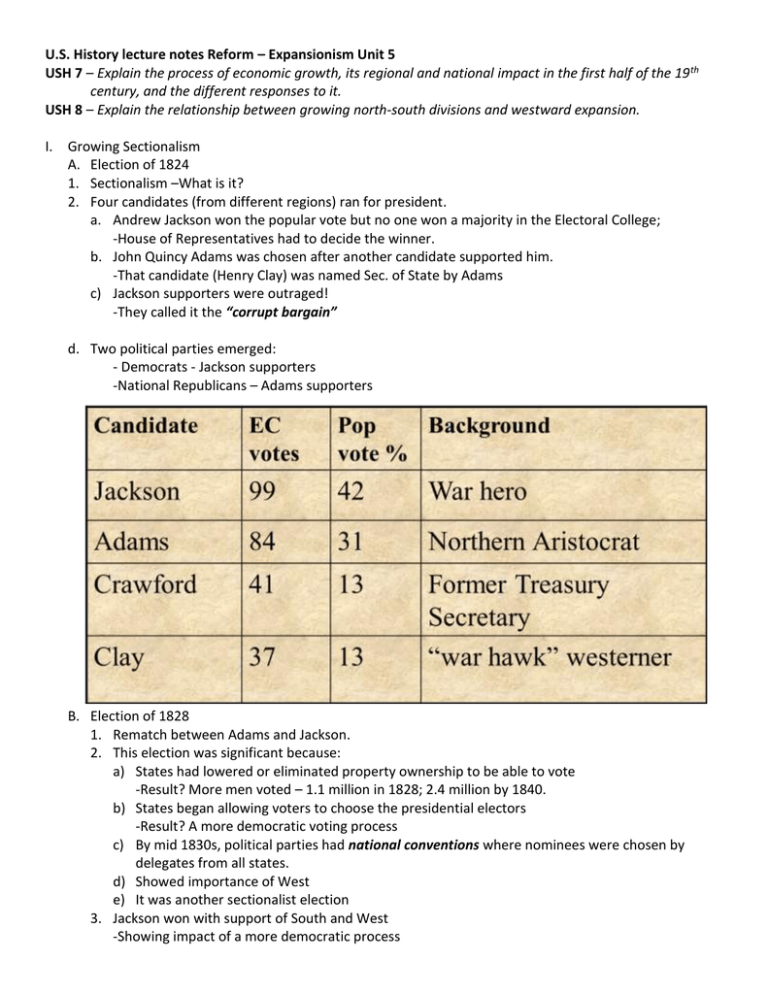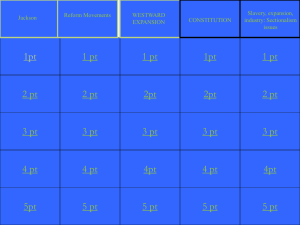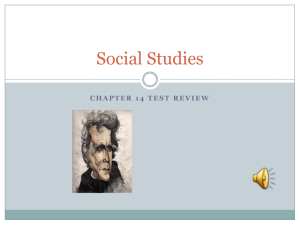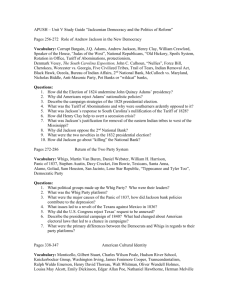Unit 5 Notes - Henry County Schools
advertisement

U.S. History lecture notes Reform – Expansionism Unit 5 USH 7 – Explain the process of economic growth, its regional and national impact in the first half of the 19 th century, and the different responses to it. USH 8 – Explain the relationship between growing north-south divisions and westward expansion. I. Growing Sectionalism A. Election of 1824 1. Sectionalism –What is it? 2. Four candidates (from different regions) ran for president. a. Andrew Jackson won the popular vote but no one won a majority in the Electoral College; -House of Representatives had to decide the winner. b. John Quincy Adams was chosen after another candidate supported him. -That candidate (Henry Clay) was named Sec. of State by Adams c) Jackson supporters were outraged! -They called it the “corrupt bargain” d. Two political parties emerged: - Democrats - Jackson supporters -National Republicans – Adams supporters B. Election of 1828 1. Rematch between Adams and Jackson. 2. This election was significant because: a) States had lowered or eliminated property ownership to be able to vote -Result? More men voted – 1.1 million in 1828; 2.4 million by 1840. b) States began allowing voters to choose the presidential electors -Result? A more democratic voting process c) By mid 1830s, political parties had national conventions where nominees were chosen by delegates from all states. d) Showed importance of West e) It was another sectionalist election 3. Jackson won with support of South and West -Showing impact of a more democratic process II. Presidency of Andrew Jackson 1829-1837 A. Jacksonian Democracy 1. Was a political philosophy shared by Jackson and his supporters that wanted: a) A stronger President b) Weaker Congress c) More public participation in government 2. The spoils system achieved the goal of more public participation in government. a) Spoils system – where political supporters were rewarded with jobs in the federal government -While appointing supporters was a longstanding tradition, Jackson first president to force out large numbers of government workers to appoint his own followers. b) Jackson argued more democratic because political offices rotated. B. Nullification Crisis 1. Tariff – is a tax on imports. 2. Tariffs were used by the government to force people to buy American-made goods. Also resulted in British buying less cotton, angering southerners 3. Southerners, led by Jackson’s own Vice President, John C. Calhoun, supported nullification. a. Nullification – states declare federal law null and void, basically ignore it. 4. The Nullification Crisis was when South Carolina threatened to nullify the most recent tariff. a) Calhoun resigned, favoring sectionalism and Congress lowered the tariff. b) Jackson favored nationalism, threatening to send troops to South Carolina. c) Significance – showed growing north-south divisions. C Indian Removal Act 1. Jackson supported manifest destiny – belief Americans had God-given right to conquer the West. 2. The Indian Removal Act of 1830 provided money and forced Native Americans to relocate further west – way to accomplish manifest destiny. a) law sectionalist because not supported by congressmen from North. 3. Cherokee refused to move and won their Supreme Court case, Worcester v. Georgia, where recognized as independent nation. 4. Jackson ignored ruling- new President Martin van Buren ordered Cherokee be relocated west on a journey known as the Trail of Tears. Here, 4000 Cherokee died along the way. D. American Nationalism 1. Along with manifest destiny, American believed U.S. superior to other nations because most Americans shared the Protestant religion, English language, ancestry and culture. III. Antebellum Reform Movements A. Background 1. The time period from Jackson’s presidency to right before the Civil War saw a number of reforms in prisons, temperance, treatment of the mentally ill, women and slaves. 2. Reformers believed our ideals of equality and liberty remained unfilled. 3. This time period also saw changes in religion. a) The Second Great Awakening, led by preachers Charles Finney and Lyman Beecher, used religion to appeal to people’s emotions and faith. b) Idea one could achieve salvation and not predestined appealing to many. 1. Richard Allen founded the A.M.E. Church in 1816 for African Americans to worship. 2. The Mormons were led first by Joseph Smith and then Brigham Young, moving through U.S. Until set up new Zion in Salt Lake City, Utah Believed in social cooperation c) Significance of Second Great Awakening – inspired social reform; led to new denominations including growth in Baptists and Methodists. B. Temperance Reform 1. Women played key role here where focus was to limit or outlaw alcohol. a) Impact – increased size of Protestant religious organizations and influence in West and rural areas. C. Prison Reform 1. Dorothea Dix worked to change horrid conditions of prisons and pushed for mentally ill persons to be placed in hospitals. a) Impact – by 1860, ¾ of states had insane asylums; prisons emphasized rehabilitation. D. Education Reform 1. Growing number of immigrants and increasing number of voters led to an interest in public education. 2. Horace Mann key leader who supported teacher training and variety of subjects in schools 3. Issue emerged that all children should be required to attend free taxpayer-supported schools a) Impact – established education as a right for all children. b) Reform was uneven and many towns either ignored the education of African American students or barred them from public schools. c) Parochial schools also founded because many public schools used textbooks with anti-Catholic bias. E. Women’s Rights 1. With Industrial Revolution, role of women changed as some women working in factories, others remained in home. 2. Women reformers resented secondary roles in politics, especially abolitionist movement, and began campaigning for more rights. 3. The Seneca Falls Convention in 1848, organized by Elizabeth Cady Stanton, is significant because: a) Declaration of Sentiments for women was issued stating women and men equal b) it’s regarded as the beginning of the women’s rights movement 4. After Seneca Falls, Stanton and Susan B. Anthony began working for women to have the right to vote and own property. F. Abolitionist Movement 1. Since the birth of the U.S., many Americans favored abolitionism – immediate ending of slavery. 2. With western expansion and a growing population, slavery became more of a divisive issue during the 1800s. 3. The Missouri Compromise of 1820 maintained the balance of free and slave states by: a) Admitting Maine as a free state, Missouri as a slave state b) Requiring that any state north of 36 degrees 30 minutes latitude would be a free state c) any state below 36 degrees 30 minutes would be a slave state -Temporary solution to growing problem 4. Some Americans favored gradualism, idea that slavery would be ended gradually. 5. Others favored colonization, where African Americans would be freed and relocated to Africa. 6. William Lloyd Garrison key white abolitionist, arguing in his newspaper The Liberator, that slavery should be abolished immediately and slaveholders not compensated. 7. Frederick Douglass was a former slave who escaped to freedom and published his own antislavery newspaper, The North Star and several autobiographies. a) Also spoke out on behalf of women, Native Americans and immigrants. 8. Sarah and Angelina Grimke spoke out regarding what they witnessed growing up on a plantation in South Carolina. -Garrison published a letter from Angelina in The Liberator, beginning their public careers. 9. Most white southerners were against abolition. Their Arguments: a) Southern economy based on large-scale agriculture that made slave labor necessary. b) Southern white culture sophisticated because of plantation economy. c) Slaves treated well and lived better lives than factory workers in North. d) Bible verses supported slavery’s existence. 10. The issue over slavery’s expansion would push us to the Civil War (1861-1865). 11. Nat Turner’s Revolt in 1831 resulted in the killing of 60 whites in Virginia. a) Turner said a solar eclipse was a message to lead the rebellion b) He was captured, tried and executed c) Rebellion’s significance - led to new laws called slave codes to limit activities of slaves & strengthen slavery’s existence. IV. Expansionism A. Mexican-American War 1 Texas had been annexed, or brought into the United States in 1845. a) Controversial because TX had gained its independence from Mexico & was a slave-holding republic. 2. U.S. asked Mexico to sell CA and NM Territories. They refused. 3. U.S. then sent troops to territory claimed by Mexico. a) Mexico fired on and killed U.S. soldiers b) War was declared in May 1846. 4. War lasted about two years. 5. The war ended in 1848 with the Treaty of Guadalupe Hidalgo Terms: a) Rio Grande River southern border of U.S. b) Mexico would give up its CA & NM territories for $15 million 6. This war is significant b/c U.S. was accomplishing its goal of manifest destiny. B. Wilmot Proviso 1. During the Mexican-American War, Congress debated if slavery should be allowed in NM & CA if these territories were taken from Mexico 2. The Wilmot Proviso stated that slavery would not be allowed to exist in any of this new territory. 3. It passed the House of Representatives but failed in the Senate, again leaving the problem of slavery’s expansion unresolved.





